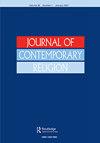宗教与触摸
IF 0.6
3区 哲学
0 RELIGION
引用次数: 0
摘要
我和接受采访的学者都认为,在今天的背景下,应该有一种批判解释学现象学。为了更好地了解这门学科是什么,它来自哪里,它要去哪里,这本书提供了一把非常有用的钥匙,可以解开围绕PoR的经常难以驾驭的辩论,在这些辩论中,学者们倾向于讨论不同的目的,并理解这个能指意味着非常不同的东西。本文章由计算机程序翻译,如有差异,请以英文原文为准。
Religion and Touch
scholars interviewed, and I have argued for a critical hermeneutical phenomenology in today’s context. To get a better sense of what the discipline is, where it came from, and where it is going, this volume provides a very useful key to unlocking the often fractious debates around the PoR, in which scholars tend to talk at cross purposes and understand this signifier to mean very different things.
求助全文
通过发布文献求助,成功后即可免费获取论文全文。
去求助
来源期刊

Journal of Contemporary Religion
RELIGION-
CiteScore
1.20
自引率
0.00%
发文量
59
期刊介绍:
Journal of Contemporary Religion is an international peer reviewed journal. Its purpose is to both document and evaluate the anthropological, sociological, psychological, and philosophical aspects of emerging manifestations of religiosity in any part of the world—whether within innovative movements or mainstream institutions. The term ''religion'' in the title of this journal is understood to include contributions on spirituality. Moreover, as the journal title suggests, the focus is on contemporary issues. Therefore, the editors of Journal of Contemporary Religion welcome submissions which deal with: classical topics in the study of religion, such as secularisation and the vitality of religion or traditional sectarian movements; more recent developments in the study of religion, including religion and social problems, religion and the environment, religion and education, the transmission of religion, the materialisation and visualisation of religion in various forms, new forms of religious pluralism, the rise of new forms of religion and spirituality, religion and the Internet, religion and science, religion and globalisation, religion and the economy, etc. theoretical approaches to the study of religion; discussions of methods in relation to empirical research; qualitative and quantitative research and related issues. The Journal includes reviews of books which reflect the above themes.
 求助内容:
求助内容: 应助结果提醒方式:
应助结果提醒方式:


